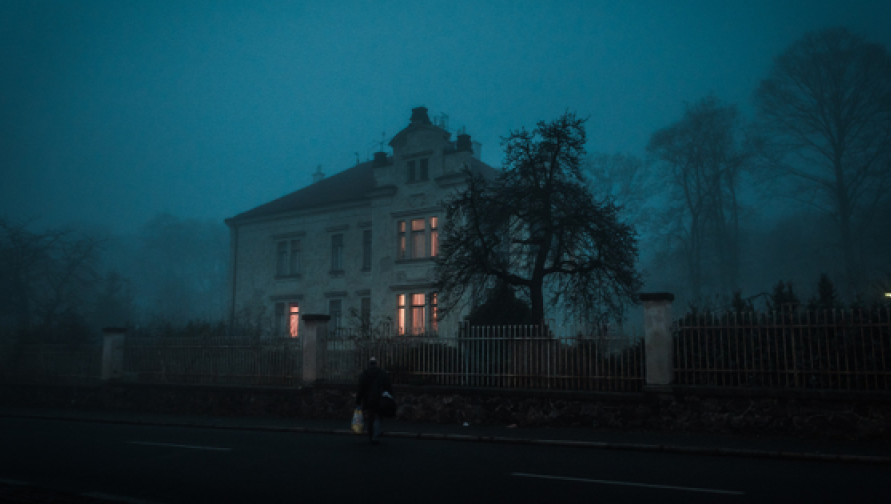
Fall. For some, it’s about hayrides and apple cider. For others, it marks the start of football and the end of baseball. For everyone, it’s about Halloween and horror movies. Whether you’re an avid fan or a once-a-year viewer, five of our School of Humanities faculty members share their scary cinema recommendations. After all, who doesn’t want to get a bit “spooked” on Oct. 31st?
1. “Let the Right One In” (2008, Dir. Tomas Alfredson)
Based on the novel by John Ajvide Lindqvist, who also wrote the screenplay, “Let the Right One In” achieves its power to spook and scare through an unusual conveyance of empathy and solidarity with and between the troubled tween protagonist, Oskar (Kåre Hedebrant, who is ignored by his parents and bullied at school), and the tween vampire he befriends, Eli (Lina Leandersson). Not only is Eli made eerily present in humanoid form (because of mutilation, s/he has become androgynous), but the setting in early 1980s Blackeberg (Stockholm) in winter yields a natural darkness in daytime, while swooping POV shots from Eli's perspective not only make us cringe, but lead us to question the living human society around Oskar. As in any good horror movie, the soundtrack is brilliant, and critical for shock effect (as in the swimming pool scene, spoiler alert).
- Catherine Benamou, associate professor, Film and Media Studies
2. “The Invitation” (2015, Dir. Karyn Kusama)
This dinner-party thriller dials up the suspense ever so slowly through small moments of polite avoidance and awkward apology. Kusama has a lot to say about how a kind of middle-class eagerness to smooth over conflict and difference can make even the most terrible things disappear in plain sight. The film's bloody climax is as sudden as it is unsurprising.
- Christopher Fan, assistant professor, English
3. “Dracula” (1931, Dir. Tod Browning)
For this year's Halloween, I recommend the 1931 film “Dracula,” which will be screened at the Segerstrom on Saturday, October 28 at 7:30 p.m., and Sunday, October 29 at 2:00 p.m. with live accompaniment by Philip Glass and the Kronos Quartet. The reason I nominate this horror classic starring Bela Lugosi is because it evokes a centuries-old blood thirst, including in the 1998 soundtrack, performed live by the composer himself at the piano, plus a Grammy Award-winning string quartet.
- Peter Krapp, chair and professor, Film and Media Studies
4. “Under the Shadow” (2016, Dir. Babak Anvari) and “Train to Busan” (2016, Dir. Yeong Sang-ho)
A haunted house film shot in the UK, taking place in Tehran during the Iraq-Iran war, “Under the Shadow” is about the mothers and daughters and Iranian politics while being played out in an updated Gothic tale about women being trapped in their homes and confined by patriarchy. It demonstrates the richness of Persian cinema's dealings with modernization, living in a city under siege and features outstanding performances and was the UK entry to the Oscars because Anvari is in exile in London.
“Train to Busan” is a Korean zombie film about class conflict, greed, Korea's self-involved successful businessmen and their refusal to take responsibility for others. Over the top and quite comical it takes many of the zombie conventions and retells the story for East Asian audiences who are suffering from whiplash with regard to intense urbanization, rampant corruption and growing inequality. Who do we care about? Who do we leave behind? A series of horrible choices ensues.
- Catherine Liu, professor, Film and Media Studies
5. “Drag Me to Hell” (2009, Dir. Sam Raimi)
A campy film about an unforgiving mortgage banker, Christine, who has been cursed by an elderly “gypsy” who has lost her home to bank foreclosure, “Drag Me to Hell” repurposes the standard tropes of horror to describe the dangers of an economy built on consumer debt. Raimi’s film references financial arcana like “toxic assets” and “financial liquidity,” but also revels in the horror’s gore… and when a corpse spews toxic embalming liquid into Christine’s mouth, it even does both at once.
- Annie McClanahan, assistant professor, English
Contributing writer: Patricia Harriman, UCI Strategic Communications & Public Affairs
